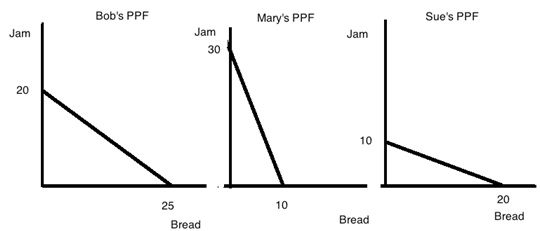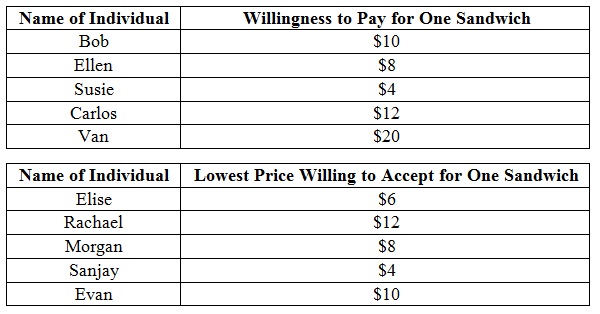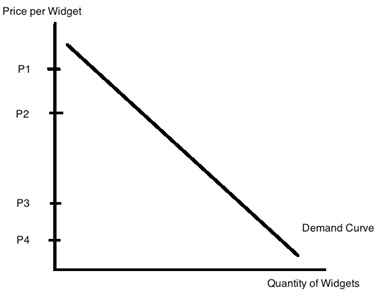Question 1. Consider three individuals: Bob, Mary and Sue. Their PPFs for producing jam and bread are given in the graphs below. The numbers refer to jars of jam and loaves of bread. Assume that Bob, Mary and Sue all have equivalent resources available to produce jam and bread.

a. Given the above information, who has the absolute advantage in the production of jam? Explain your answer.
b. Given the above information, who has the absolute advantage in the production of bread? Explain your answer.
c. Given the above information, who has the comparative advantage in the production of jam? Explain your answer.
d. Given the above information, who has the comparative advantage in the production of bread? Explain your answer.
e. Draw the joint PPF for these three individuals based upon the given information. Measure jam on the vertical axis and bread on the horizontal axis. Identify the coordinate values (bread, jam) for any kink point or axis intercept. Also, at each kink point identify the good and level of production that each individual is contributing.
Question 2. Analyze the following scenarios using the demand and supply model.
a. Consider the market for bicycles in Seattle. Seattle has recently imposed a large carbon tax on gasoline and this tax effectively increases the cost of driving a car by 25%, and taking the bus or metro transportation by 20%. What effect on the market for bicycles do you think this carbon tax will have? Explain your answer fully and provide a prediction about both the price and quantity of bicycles in this market. Assume that everything else is held constant in this market scenario except for this excise tax. Provide a graph to illustrate your answer.
b. Consider the market for fig jam that is initially in equilibrium. Suppose that there is a hard freeze that destroys 60% of the fig crop for this year (figs are very sensitive to cold!) while at the same time a well-respected health report publishes a study showing that consumption of fig jam reduces stress and therefore benefits overall health. Analyze the impact of this information on the market for fig jam: in particular, identify what happens to the equilibrium price and equilibrium quantity in this market. Assume that everything else is held constant in this market scenario. Provide a graph to illustrate your answer. As usual use P1, Q1 to indicate the initial situation and P2, Q2 to indicate the new levels.
c. Consider the market for Starbuck’s Coffee. Yesterday while traveling I stopped to buy a cup of coffee and after making my purchase I was told by the barista that if I stopped after one later in the same day at any Starbuck’s I could get a pastry for just a $1 with my receipt. Examine this offer and analyze its impact on the market for Starbuck’s Coffee. Provide a graph to illustrate your answer. In your answer also reflect on the effect of this policy on the company’s revenue.
Question 3. Suppose you are given the following information about the market for turkey sandwiches:

a. Given the above information, if the market provides only one sandwich, who will purchase that sandwich and who will provide that sandwich?
b. Given the above information, how many sandwiches will the market provide? Who will provide sandwiches? Explain your answer.
c. Given the above information, who will get sandwiches in this market? Explain your answer.
d. Given the above information, calculate the value of total surplus in the market for sandwiches.
Question 4. Examine the table below that provides data about the price of gadgets and the quantity demanded and the quantity supplied of gadgets at these various prices.

a. Given the above information, if the price of a gadget is $3, then this market will have _________.
b. Given the above information, if the price of a gadget is $7, then this market will have ________.
c. Given the above information, the equilibrium price in this market must be greater than _____ and less than ______.
d. Given the above information, the equilibrium quantity in this market must be less than ________ and greater than _________. In your answer determine the narrowest range of quantities!
Question 5. Use the graph below of the market demand curve for widgets to answer the following set of questions.

a. In the above graph determine the quantity demanded at each of the four given prices: P1, P2, P3, and P4. Label these quantities Q1, Q2, Q3, and Q4 respectively.
b. If the price is initially P1 and then it falls to P2, how much revenue is lost due to this price change? Show this revenue lost in a well-labeled graph. How much revenue is gained due to this price change? Show this revenue gained in the same well-labeled graph.
c. Suppose the price is initially P4 and then it rises to P3. What happens to total revenue in this market with this price change? Give a complete verbal explanation of this change in your answer. And, provide a graph to illustrate what is happening to total revenue.
d. When price falls and total revenue increases this tells us that the demand for the good is ____________. When price falls and total revenue decreases this tells us that the demand for the good is ____________.
e. When price rises and total revenue increases this tells us that the demand for the good is _________. When price rises and total revenue decreases this tells us that the demand for the good is _____________.
Question 6. Let’s go back to that Starbuck’s Coffee example from earlier in this homework (Problem 2c in this homework). The offer from Starbuck’s Coffee yesterday while traveling was that if I took my receipt to any Starbuck’s Coffee after 1 in the afternoon on the same day I could get a pastry for $1 instead of its regular price. So, let’s try to analyze why the company might make this offer. To do this we will need to make some assumptions and we will try to keep the example as simple as possible. So, suppose you are given the following information:
• Daily number of cups of coffee sold before noon: 1000 cups
• Daily number of cups of coffee sold after noon: 400 cups
• Cost of providing a cup of coffee: $0.50 per cup of coffee
• Price of cup of coffee: $3.00 per cup of coffee
• Daily number of pastries sold before noon: 800 pastries
• Daily number of pastries sold after noon: 320 pastries
• Cost of providing a pastry: $0.40 per pastry
• Price of pastry: $3.00 per pastry
• Assume there are no other costs or revenue sources for Starbuck’s Coffee
a. Given the above information calculate the total cost of providing coffee per day, the total revenue from selling the coffee per day, and the total profit made from selling coffee per day. Show all your work.
b. Given the above information calculate the total cost of providing pastries per day, the total revenue from selling the pastries per day, and the total profit made from selling pastries per day. Show all your work.
c. Given the above information calculate the total profit made from selling coffee and pastries per day. Show all your work.
Now, suppose that Starbuck’s introduces this afternoon pastry incentive plan whereby if you buy a cup of coffee in the morning you can use your receipt later in the day to purchase a pastry for $1.00 instead of the usual $3.00 per pastry. Starbuck’s finds that with this plan it is now selling a total of 600 cups of coffee in the afternoon and a total of 480 pastries in the afternoon.
d. Calculate the additional profit from selling coffee that Starbuck’s gets per day once it institutes this plan. Show your work.
e. Calculate the additional profit from selling pastries that Starbuck’s gets per day once it institutes this plan. Show your work.
f. With this incentive plan what is the value of Starbuck’s daily profit from selling coffee and pastries? Calculate the percentage increase in profits that Starbuck’s experiences by adopting this pricing plan. Show all your work. Is it worth Starbuck’s instituting this change?
Question 7. Let’s return to the task of outlining a chapter that we have read. On Homework #1 you outlined Chapter 2 of Wheelan’s book Naked Economics: in this homework outline Chapter 3 of this same book using a short outline (not the more extensive long outline). My hope is that repeating this task on another set of materials will help your skill set improve. After you do the outline, write a brief essay summarizing your experience: are you better at this, what is hard for you, does this help you retain or organize the material you have read. What is good about this task for you? What is bad about this task for you?
Question 8. Read Chapter 4 of Wheelan and then write an essay of at least five paragraphs (you will understand this number in a moment) about something that you thought was interesting in the text. In the first paragraph include a thesis sentence and a brief summary of the points you will expand on (at least three points you want to make). Then in the next three paragraphs expand on each of these points and thenyou’re your final paragraph write a conclusion. Work on your ability to express yourself. If you quote from the book note that by placing quotation marks around the quote and placing the page number in brackets (for example, [page 3]). It is good to get in the habit of attributing your sources! Remember I will be looking at your expression of ideas and evaluating this primarily on whether you convince me that you took some time writing your statement: if you do this in a slapdash manner I suspect I will know that!
Question 9. In Chapter 5 of Wheelan identify three examples that you thought were interesting and using bullet points identify the example and a bit of description or commentary on what you found interesting. Here is an example of this task from Chapter 2:
• Hunting of black rhinos
o Horn of black rhino prized in some cultures
o Black rhinos are more valuable dead than alive
o Local villagers may not think black rhinos as valuable as safari travels feel they are